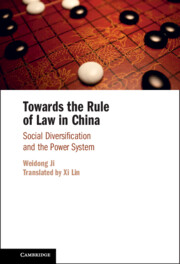Book contents
- Toward the Rule of Law in China
- Epigraph
- Toward the Rule of Law in China
- Copyright page
- Contents
- Foreword
- Acknowledgments
- Translator’s Note
- Abbreviations
- Introduction
- 1 The Conception of Law in Traditional China
- 2 The Essence of Modern Rule of Law
- 3 The Rule of Law: Contemporary Challenges and Paradigmatic Innovation
- 4 A Rule-of-Law Democracy (Rechtsdemokratie): Social Diversification and Reconstructing the System of Authority
- 5 Judicial Reform in China: The Status Quo and Future Directions
- 6 Reconstructing Legal Ideology
- Postscript
- Book part
- References
- Index
2 - The Essence of Modern Rule of Law
Published online by Cambridge University Press: 24 February 2022
- Toward the Rule of Law in China
- Epigraph
- Toward the Rule of Law in China
- Copyright page
- Contents
- Foreword
- Acknowledgments
- Translator’s Note
- Abbreviations
- Introduction
- 1 The Conception of Law in Traditional China
- 2 The Essence of Modern Rule of Law
- 3 The Rule of Law: Contemporary Challenges and Paradigmatic Innovation
- 4 A Rule-of-Law Democracy (Rechtsdemokratie): Social Diversification and Reconstructing the System of Authority
- 5 Judicial Reform in China: The Status Quo and Future Directions
- 6 Reconstructing Legal Ideology
- Postscript
- Book part
- References
- Index
Summary
The construction of the rule-of-law order (Rechtsordnung) has importance in defining the future development of China. For one thing, China will embrace a structure of social pluralism on the basis of its market reform and internationalization of the late twentieth century – a structure where social integration cannot be achieved via naked power or a strong authoritarian hand. It is of necessity that power is restrained to an appropriate degree. In addition, a new authority should be established to serve as the core to build social consensus and coordinate actions. By the way of comparison, the institutional design of a modern rule-of-law state (Rechtsstaat) can as much prevent power from encroaching upon liberty and autonomy as establish a uniform system of norms for a multilayered, pluralized society. At the level of value commitment, it legitimates the whole system, which is fundamental for us to call attention to when considering the reconfiguration of power structure or of the system of authority.
- Type
- Chapter
- Information
- Towards the Rule of Law in ChinaSocial Diversification and the Power System, pp. 34 - 63Publisher: Cambridge University PressPrint publication year: 2022

